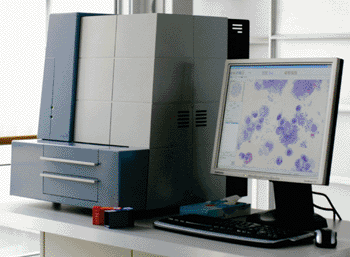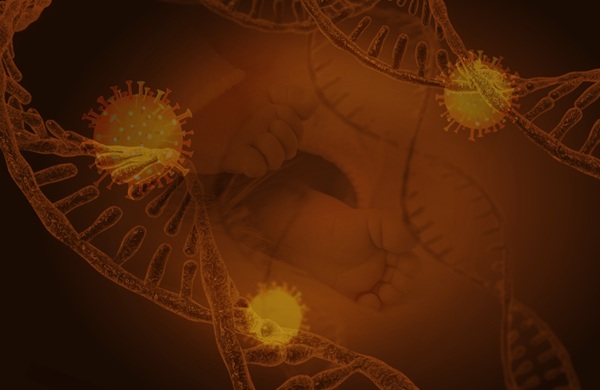Leucocytes Identified by Automated Digital Morphology System
|
By LabMedica International staff writers Posted on 31 Oct 2013 |

Image: CellaVision DM96 Digital Cell Morphology System (Photo courtesy of CellaVision).
An automated digital cell morphology analyzer for determining leukocyte differential counts in peripheral blood smears (PBS) has been evaluated in a clinical laboratory.
The differential counting of peripheral blood leukocytes is one of the most frequently ordered laboratory tests by clinicians as it is an important test for the diagnosis of various hematologic diseases and systemic diseases. Improvements in laboratory technologies have benefited from the development of automated blood cell counters that have begun to replace the manual microscopic counting that is still performed in most laboratories.
Laboratory scientists at the University of Ulsan College of Medicine and Asan Medical Center (Seoul, Republic of Korea) examined a total of 308 peripheral blood samples with quantitative or qualitative abnormalities, for which complete blood counts had been ordered by clinicians. These samples were initially analyzed using the automatic blood cell analyzer Sysmex XE-2100 (Sysmex; Kobe, Japan), and the total leukocyte and differential counts were determined. Manual microscopic differential counts of 100 cells on each slide were separately performed by two independent well-trained laboratory technologists.
The slides were labeled and loaded into the CellaVision DM96 system (CellaVision AB; Lund, Sweden) after manual microscopic differential counting. In cases with a buffy coat preparation, the slides were prepared using samples prior to buffy coat preparation and labeled in the CellaVision DM96 system To evaluate the clinical relevance of the extension of cell counts up to 300 or 500 cells, which is the provided function by the CellaVision DM96 system, in the samples with low leukocyte count of less than 1,000 cells/μL, correlation analysis between the CellaVision DM96 system and manual count was performed.
The correlation coefficients between two methods were consistently high, ranged from 0.864 to 0.992. The sensitivity, specificity, positive predictive value, negative predictive values of this system for the identification of abnormalities was consistently high, especially for blast cells. When the instrument was instructed to count 300 or 500 cells from the operator, better performance was demonstrated than 100 cells in the leukopenic samples by sacrificing only 40 seconds/slide on average.
The authors concluded that the CellaVision DM96 system is useful in the clinical laboratory providing comparative accuracy compared with manual counts in samples with abnormalities. In leukopenic samples, report quality can be improved by ordering to count 300 or 500 cells from the operator without severe prolongation of turnaround time. The study was published on the October 2013 issue of the International Journal of Laboratory Hematology .
Related Links:
University of Ulsan College of Medicine and Asan Medical Center
Sysmex
CellaVision AB
The differential counting of peripheral blood leukocytes is one of the most frequently ordered laboratory tests by clinicians as it is an important test for the diagnosis of various hematologic diseases and systemic diseases. Improvements in laboratory technologies have benefited from the development of automated blood cell counters that have begun to replace the manual microscopic counting that is still performed in most laboratories.
Laboratory scientists at the University of Ulsan College of Medicine and Asan Medical Center (Seoul, Republic of Korea) examined a total of 308 peripheral blood samples with quantitative or qualitative abnormalities, for which complete blood counts had been ordered by clinicians. These samples were initially analyzed using the automatic blood cell analyzer Sysmex XE-2100 (Sysmex; Kobe, Japan), and the total leukocyte and differential counts were determined. Manual microscopic differential counts of 100 cells on each slide were separately performed by two independent well-trained laboratory technologists.
The slides were labeled and loaded into the CellaVision DM96 system (CellaVision AB; Lund, Sweden) after manual microscopic differential counting. In cases with a buffy coat preparation, the slides were prepared using samples prior to buffy coat preparation and labeled in the CellaVision DM96 system To evaluate the clinical relevance of the extension of cell counts up to 300 or 500 cells, which is the provided function by the CellaVision DM96 system, in the samples with low leukocyte count of less than 1,000 cells/μL, correlation analysis between the CellaVision DM96 system and manual count was performed.
The correlation coefficients between two methods were consistently high, ranged from 0.864 to 0.992. The sensitivity, specificity, positive predictive value, negative predictive values of this system for the identification of abnormalities was consistently high, especially for blast cells. When the instrument was instructed to count 300 or 500 cells from the operator, better performance was demonstrated than 100 cells in the leukopenic samples by sacrificing only 40 seconds/slide on average.
The authors concluded that the CellaVision DM96 system is useful in the clinical laboratory providing comparative accuracy compared with manual counts in samples with abnormalities. In leukopenic samples, report quality can be improved by ordering to count 300 or 500 cells from the operator without severe prolongation of turnaround time. The study was published on the October 2013 issue of the International Journal of Laboratory Hematology .
Related Links:
University of Ulsan College of Medicine and Asan Medical Center
Sysmex
CellaVision AB
Latest Hematology News
- MRD Tests Could Predict Survival in Leukemia Patients
- Platelet Activity Blood Test in Middle Age Could Identify Early Alzheimer’s Risk
- Microvesicles Measurement Could Detect Vascular Injury in Sickle Cell Disease Patients
- ADLM’s New Coagulation Testing Guidance to Improve Care for Patients on Blood Thinners
- Viscoelastic Testing Could Improve Treatment of Maternal Hemorrhage
- Pioneering Model Measures Radiation Exposure in Blood for Precise Cancer Treatments
- Platelets Could Improve Early and Minimally Invasive Detection of Cancer
- Portable and Disposable Device Obtains Platelet-Rich Plasma Without Complex Equipment
- Disposable Cartridge-Based Test Delivers Rapid and Accurate CBC Results
- First Point-of-Care Heparin Monitoring Test Provides Results in Under 15 Minutes

- New Scoring System Predicts Risk of Developing Cancer from Common Blood Disorder
- Non-Invasive Prenatal Test for Fetal RhD Status Demonstrates 100% Accuracy
- WBC Count Could Predict Severity of COVID-19 Symptoms
- New Platelet Counting Technology to Help Labs Prevent Diagnosis Errors
- Streamlined Approach to Testing for Heparin-Induced Thrombocytopenia Improves Diagnostic Accuracy
- POC Hemostasis System Could Help Prevent Maternal Deaths
Channels
Clinical Chemistry
view channel
Blood Test Could Predict and Identify Early Relapses in Myeloma Patients
Multiple myeloma is an incurable cancer of the bone marrow, and while many patients now live for more than a decade after diagnosis, a significant proportion relapse much earlier with poor outcomes.... Read more
Compact Raman Imaging System Detects Subtle Tumor Signals
Accurate cancer diagnosis often depends on labor-intensive tissue staining and expert pathological review, which can delay results and limit access to rapid screening. These conventional methods also make... Read moreMolecular Diagnostics
view channel
Ultra-Sensitive Blood Biomarkers Enable Population-Scale Insights into Alzheimer’s Pathology
Accurately estimating how many people carry Alzheimer’s disease pathology has long been a challenge, as traditional methods rely on small, clinic-based samples rather than the general population.... Read more
Blood Test Could Predict Death Risk in World’s Most Common Inherited Heart Disease
Hypertrophic cardiomyopathy (HCM) is the world’s most common inherited heart condition and affects millions of people globally. While some patients live with few or no symptoms, others develop heart failure,... Read moreImmunology
view channel
Ultrasensitive Liquid Biopsy Demonstrates Efficacy in Predicting Immunotherapy Response
Immunotherapy has transformed cancer treatment, but only a small proportion of patients experience lasting benefit, with response rates often remaining between 10% and 20%. Clinicians currently lack reliable... Read more
Blood Test Could Identify Colon Cancer Patients to Benefit from NSAIDs
Colon cancer remains a major cause of cancer-related illness, with many patients facing relapse even after surgery and chemotherapy. Up to 40% of people with stage III disease experience recurrence, highlighting... Read moreMicrobiology
view channel
New UTI Diagnosis Method Delivers Antibiotic Resistance Results 24 Hours Earlier
Urinary tract infections affect around 152 million people every year, making them one of the most common bacterial infections worldwide. In routine medical practice, diagnosis often relies on rapid urine... Read more
Breakthroughs in Microbial Analysis to Enhance Disease Prediction
Microorganisms shape human health, ecosystems, and the planet’s climate, yet identifying them and understanding how they are related remains a major scientific challenge. Even with modern DNA sequencing,... Read morePathology
view channel
Genetics and AI Improve Diagnosis of Aortic Stenosis
Aortic stenosis is a progressive narrowing of the aortic valve that restricts blood flow from the heart and can be fatal if left untreated. There are currently no medical therapies that can prevent or... Read more
AI Tool Simultaneously Identifies Genetic Mutations and Disease Type
Interpreting genetic test results remains a major challenge in modern medicine, particularly for rare and complex diseases. While existing tools can indicate whether a genetic mutation is harmful, they... Read more
Rapid Low-Cost Tests Can Prevent Child Deaths from Contaminated Medicinal Syrups
Medicinal syrups contaminated with toxic chemicals have caused the deaths of hundreds of children worldwide, exposing a critical gap in how these products are tested before reaching patients.... Read more
Tumor Signals in Saliva and Blood Enable Non-Invasive Monitoring of Head and Neck Cancer
Head and neck cancers are among the most aggressive malignancies worldwide, with nearly 900,000 new cases diagnosed each year. Monitoring these cancers for recurrence or relapse typically relies on tissue... Read moreTechnology
view channel
Pioneering Blood Test Detects Lung Cancer Using Infrared Imaging
Detecting cancer early and tracking how it responds to treatment remains a major challenge, particularly when cancer cells are present in extremely low numbers in the bloodstream. Circulating tumor cells... Read more
AI Predicts Colorectal Cancer Survival Using Clinical and Molecular Features
Colorectal cancer is one of the most common and deadly cancers worldwide, and accurately predicting patient survival remains a major clinical challenge. Traditional prognostic tools often rely on either... Read moreIndustry
view channel
BD and Penn Institute Collaborate to Advance Immunotherapy through Flow Cytometry
BD (Becton, Dickinson and Company, Franklin Lakes, NJ, USA) has entered into a strategic collaboration with the Institute for Immunology and Immune Health (I3H, Philadelphia, PA, USA) at the University... Read more





















